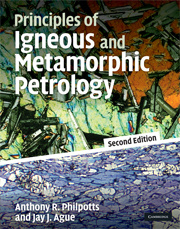Book contents
- Frontmatter
- Contents
- Preface
- Acknowledgments
- List of units
- 1 Introduction
- 2 Physical properties of magma
- 3 Intrusion of magma
- 4 Forms of igneous bodies
- 5 Cooling of igneous bodies and other diffusion processes
- 6 Classification of igneous rocks
- 7 Introduction to thermodynamics
- 8 Free energy and phase equilibria
- 9 Thermodynamics of solutions
- 10 Phase equilibria in igneous systems
- 11 Effects of volatiles on melt equilibria
- 12 Crystal growth
- 13 Isotope geochemistry related to petrology
- 14 Magmatic processes
- 15 Igneous rock associations
- 16 Metamorphism and metamorphic facies
- 17 Deformation and textures of metamorphic rocks
- 18 Graphical analysis of metamorphic mineral assemblages
- 19 Geothermometry, geobarometry, and mineral reactions among solid solutions
- 20 Mineral reactions involving H2O and CO2
- 21 Material transport during metamorphism
- 22 Pressure–temperature–time paths and heat transfer during metamorphism
- 23 Origin of rocks
- Answers to selected numerical problems
- References
- Index
7 - Introduction to thermodynamics
- Frontmatter
- Contents
- Preface
- Acknowledgments
- List of units
- 1 Introduction
- 2 Physical properties of magma
- 3 Intrusion of magma
- 4 Forms of igneous bodies
- 5 Cooling of igneous bodies and other diffusion processes
- 6 Classification of igneous rocks
- 7 Introduction to thermodynamics
- 8 Free energy and phase equilibria
- 9 Thermodynamics of solutions
- 10 Phase equilibria in igneous systems
- 11 Effects of volatiles on melt equilibria
- 12 Crystal growth
- 13 Isotope geochemistry related to petrology
- 14 Magmatic processes
- 15 Igneous rock associations
- 16 Metamorphism and metamorphic facies
- 17 Deformation and textures of metamorphic rocks
- 18 Graphical analysis of metamorphic mineral assemblages
- 19 Geothermometry, geobarometry, and mineral reactions among solid solutions
- 20 Mineral reactions involving H2O and CO2
- 21 Material transport during metamorphism
- 22 Pressure–temperature–time paths and heat transfer during metamorphism
- 23 Origin of rocks
- Answers to selected numerical problems
- References
- Index
Summary
INTRODUCTION
Thermodynamics, the study of energy, is one of the most important subjects in all of science. Historically, it evolved from the desire to understand the efficiency of machines, in particular of steam engines. Much of its terminology, therefore, centers around heat and work, especially work associated with expanding gas. Thermodynamics, however, deals with the transfer of other forms of energy, such as that associated with chemical reactions. Although heat and mechanical work done by expanding gas are important in geology, for example in the cooling of a magma or the explosion of a volcano, it is in the study of chemical energies that thermodynamics is of greatest value to petrology. It is particularly useful in the study of processes that take place within the Earth, where they cannot be observed directly. The increased availability in recent years of thermodynamic data for the common minerals and magmas has resulted in a rapid growth in the application of thermodynamics to petrologic problems, and computer programs now use these data to calculate the compositions of minerals crystallizing from magmas and the mineral assemblages that can form in metamorphic rocks under any given temperature and pressure.
The general applicability of thermodynamics stems from the fundamental nature of the principles on which it is based, namely simple observations on the behavior of energy. For example, although energy can be converted from one form to another (kinetic to potential, chemical to thermal, etc.), it can never be destroyed.
- Type
- Chapter
- Information
- Principles of Igneous and Metamorphic Petrology , pp. 149 - 163Publisher: Cambridge University PressPrint publication year: 2009



